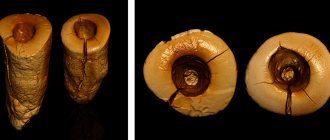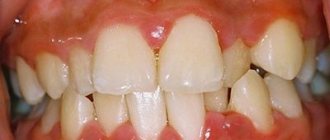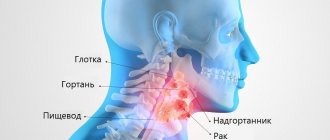Our clinic in most cases prefers conservative treatment of chronic tonsillitis, preserving the tonsils as an organ of immunity. Tonsils are organs of the immune system in the oral cavity and pharynx, so we strive to preserve the tonsils and restore their functionality. We employ experienced otorhinolaryngology and immunologists. How the treatment will be structured: we will find and treat the infection, wash away the pus from the lacunae of the tonsils, and carry out treatment to restore immunity.
We will be glad to help you in the treatment of chronic tonsillitis (tonsils)!
- Causes and symptoms of chronic tonsillitis
- Why is chronic tonsillitis dangerous?
- Diagnosis and treatment of chronic tonsillitis. Treatment at the Echinacea Clinic
Video about the treatment of chronic tonsillitis
Exacerbation of chronic tonsillitis: symptoms
Often, for a long time, chronic tonsillitis occurs without symptoms or has scanty symptoms (in a simple form). There may be discomfort when swallowing food and liquids, a sensation of a foreign body in the throat, dry mouth, halitosis (bad odor) and tingling. Externally, the tonsils increase in size and there are signs of inflammation. The disease is characterized by exacerbations of sore throats up to three times a year, long periods of recovery, with general symptoms of asthenia and prolonged low-grade fever.
For the toxic-allergic form, more frequent exacerbations are typical, often with complications in the area of neighboring tissues (pharyngitis, peritonsillar abscesses), and the almost constant presence of asthenia and prolonged fever are typical.
The clinical picture of chronic tonsillitis during an exacerbation is as follows:
- sore throat that gets worse when swallowing;
- redness of the throat and tonsils;
- characteristic plaque;
- purulent discharge from the tonsils;
- bad breath;
- swelling of the nasopharynx;
- temperature increase;
- weakness;
- headache;
- fast fatiguability;
- arrhythmia;
- enlarged lymph nodes;
- dyspnea.
Reasons for the appearance of a purulent odor during inflammation of the tonsils
Why does my breath smell when I have tonsillitis? The tonsils, which have natural depressions or lacunae, absorb most of the pathogenic bacteria - pathogenic microorganisms, while retaining the remnants of their vital activity, decomposing pieces of food and particles of dead cells of the tissues of the oral cavity. This is exactly how unpleasant clots appear on the tonsils, causing over time the appearance of a purulent odor.
The inflammatory process can occur for various reasons (hypothermia; bacterial or viral infections; dental diseases and much more), but the consequence of this most often is the formation of purulent plugs in the lacunae of the tonsils . It is from them that the unpleasant odor of pus comes from the mouth. In advanced forms of the disease, these plugs turn into almond stones : they harden in the lacunae of the tonsils when calcium salts are deposited. Often patients can see them with their mouths wide open: white calcified deposits appear on the inflamed tonsils, which give off an unpleasant odor.
What do tonsil plugs and stones look like?
Causes, main risk factors
Up to 30 different colonies of pathogenic microbes can be sown on the surface of the tonsils of patients suffering from chronic tonsillitis. But in crypts and lacunae staphylo- or streptococcus is usually determined. A key role in the pathogenesis of chronic tonsillitis is played by beta-hemolytic strains of streptococcus (type A). Other flora - gram-negative coccal, fungal, viral - have an impact on local immunity, they support inflammation.
There are a number of factors contributing to the occurrence of the disease:
- hypothermia;
- decreased immunity;
- microtrauma of the tonsils;
- foci of inflammation in the mouth and in the head area (caries, sinusitis, adenoids, etc.);
- smoking;
- poor nutrition;
- allergy.
Viruses and bacteria that cause tonsillitis can come from the external environment.
Classification
Doctors distinguish various clinical forms of chronic tonsillitis, differing in clinical manifestations, severity of the condition and prognosis, risk of complications, as well as treatment tactics.
The simple form of chronic tonsillitis is characterized by a predominance of local symptoms. If general manifestations and lymphadenitis occur, this is referred to as a toxic-allergic form of tonsillitis. It comes in two versions:
Toxic-allergic chronic tonsillitis 1st degree . Sore throats are typical for him, which can worsen after ARVI, combined with general symptoms.
Toxic-allergic chronic tonsillitis of the 2nd degree - the symptoms are more pronounced, associated with diseases that have common factors of etiology and pathogenesis.
According to the degree of compensation of the process, the disease is divided into two options:
- chronic tonsillitis, compensated form - the source of infection is in a dormant state, there are no reactions from the body, repeated sore throats do not occur; The function of the tonsils and general reactivity are not impaired.
- chronic tonsillitis is a decompensated form - relapses of sore throat occur, complications of the heart, damage to the paranasal sinuses, middle ear, and renal complications are possible.
According to pathomorphological criteria, the process is divided into the following options:
- lacunar tonsillitis with predominant damage to the area of the lacunae;
- parenchymal-lacunar, involving in addition to the lacunae also the area of the lymphoid tissue of the tonsils themselves;
- phlegmonous - inflammation is predominantly localized in the area of lymphoid tissue;
- sclerotic with abundant growth of connective tissue fibers in the area of the tonsils and surrounding tissue.
Treatment regimen for bad breath, tonsillitis and conclusions
The patient’s main question when contacting her was whether her tonsils need to be removed to solve the problem? When examining the nose, no visible nasal problems were identified. X-ray of the paranasal sinuses was performed without pathology. Consulted with a dentist, the oral cavity was sanitized. The gastroenterologist did not identify any problems with the gastrointestinal tract.
Pharyngoscopy : the pharynx mucosa is pink, the palatine tonsils are not enlarged, the anterior palatine arches are hyperemic. When rotating and pressing on the tonsils, a cheesy discharge emerged from 2 large lacunae, which, according to the patient, had exactly “that smell.”
The treatment regimen I carried out:
- The tonsils were washed with octenisept solution and Triderm ointment was injected into the tonsils for 7 days.
- Phonophoresis was performed on the submandibular region, the area of projection of the palatine tonsils.
- After cleaning the lacunae, a week later radio wave “sealing” of the lacunae was performed using the Surgitron radio wave apparatus. The purpose of the procedure was to exclude gaps from the process of accumulation and production of caseous masses by “gluing” them together.
In some patients, he used other methods: cryolakunotomy - he froze the lacunae, if the size allowed, which led to the expansion of the lacunae, the improvement of the tonsils and subsequently to their self-cleaning. In some cases, the expansion of the outlet of the lacuna was carried out by removing the “interfering” area, which led to the formation of a wide outlet.
Complications of chronic tonsillitis
Against the background of a chronic inflammatory process in the tonsil area, various complications are possible. Therefore, it is important to know why chronic tonsillitis is dangerous. Thus, the tonsils themselves, losing their function as a barrier to infection, become its breeding ground. Inside them are pathogens with the products of their metabolism. The infection can spread throughout organs and tissues, affecting the renal parenchyma, joint and heart tissue, and liver. In addition, tonsillitis adversely affects the functioning of the immune system and can be a provocateur of collagen diseases - lupus, scleroderma, dermatomyositis, periarteritis. The skin and peripheral nerve fibers may also be affected. With prolonged intoxication against the background of the disease, damage to blood vessels (vasculitis) and platelets (purpura) is possible.
Why is tonsillitis dangerous?
Chronic tonsillitis is very dangerous: if you do not consult a specialist in a timely manner and self-medicate, complications may develop, among which the most dangerous are diseases of the heart and blood vessels, and rheumatic joint damage.
Tonsillitis in adults often leads to damage to the kidneys ( tonsillorenal syndrome ) and heart ( tonsillocardiac syndrome ). This is due to the fact that infectious and toxic factors that damage internal organs enter the body from the palatine tonsils. Streptococcus, for example, secretes a toxin, the effects of which can cause myocardial dystrophy and heart disease or rheumatism . In addition, purulent contents entering the gastrointestinal tract from the lacunae of the tonsils can provoke dysbacteriosis.
Diagnostics
Diagnosis of chronic tonsillitis occurs on the basis of complaints, examination of the patient, and questioning of the patient. Objective signs, manifestations of chronic tonsillitis, and the general condition of the tonsils are important; the doctor determines the stages of the process and the form.
The following diagnostic procedures are also carried out:
- throat swab for flora;
- general blood and urine tests;
- blood test for antibodies to streptococcus.
This helps determine treatments for chronic tonsillitis.
Treatment methods in adults
In most cases, they resort to conservative treatment of chronic tonsillitis. Source: Modern methods of treating chronic tonsillitis. Ryazantsev S.V., Eremina N.V., Shcherban K.Yu. Medical Council, 2021. p. 68-72:
- therapy for inflammation in the head and oral cavity;
- procedures that increase immunity (hardening, taking vitamins, physical education, etc.);
- hyposensitizing drugs (to suppress allergic reactions);
- immunomodulators (normalize the immune system);
- means of reflex action (acupuncture, manual therapy);
- washing the tonsils with antiseptics;
- administration of drugs to the tonsils.
The treatment plan is complemented by physical therapy for chronic tonsillitis.
A radical method of treating chronic tonsillitis is surgical removal of the tonsils (tonsillectomy). The operation is performed in cases where inflammation occurs more than five times a year and does not respond to complex conservative treatment of chronic tonsillitis. Source: Choosing an antibiotic for exacerbation of tonsillitis. Karpishchenko S.A., Kolesnikova O.M. Medical Council, 2015. p. 40-43.
Causes of tonsillitis development
The main factors that trigger the pathological process are:
- infectious diseases that the patient tried to cure with home and folk methods;
- frequent pharyngitis, which reduces the body’s immunity and causes inflammation of the throat mucosa;
- allergic reactions that weaken the body;
- dental diseases, treatment of which has been postponed indefinitely;
- low immunity after suffering serious illnesses or prolonged stressful situations;
- congenital pathologies of the structure of the respiratory tract, curvature of the nasal septum.
All of the listed causes of tonsillitis are summarized by one main factor – weakening of the immune system and deterioration of the body’s condition. Having lost the ability to resist infections, it becomes vulnerable to pathogenic microorganisms that cause prolonged colds and inflammation of the mucous membrane.
Prevention of chronic tonsillitis in adults
Preventive measures to prevent chronic tonsillitis include:
- proper hygiene;
- hardening;
- balanced diet;
- maintaining cleanliness in the home and workplace, eliminating dust;
- timely treatment of inflammationSource: Treatment and prevention of chronic tonsillitis. Atagulova G. Zh. Medicine and ecology, 2012.
Chronic tonsillitis is a very common disease that causes a lot of inconvenience to the patient. But is it possible to cure chronic tonsillitis? If your tonsils often become inflamed, then do not self-medicate, but consult a doctor who will select the optimal treatment regimen for you and determine how to get rid of chronic tonsillitis. You can make an appointment with a medical specialist in St. Petersburg by calling the phone number listed on the website.
Article sources:
- Treatment and prevention of chronic tonsillitis. Atagulova G. Zh. Medicine and ecology, 2012
- Chronic tonsillitis in the practice of an otolaryngologist and cardiologist. Yalymova D.L., Kostyuk V.N., Vishnyakov V.V., Yalymov A.A., Shekhyan G.G., Zadionchenko V.S. Cardio Somatics, 2014. p. 60-65
- Choice of antibiotic for exacerbation of tonsillitis. Karpishchenko S.A., Kolesnikova O.M. Medical Council, 2015. p. 40-43
- Modern methods of treating chronic tonsillitis. Ryazantsev S.V., Eremina N.V., Shcherban K.Yu. Medical Council, 2021. p. 68-72











